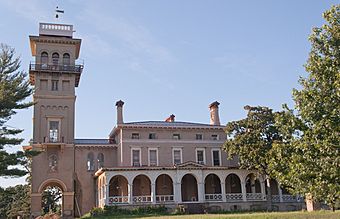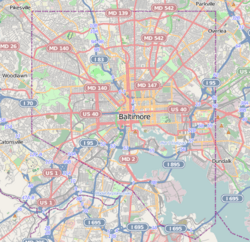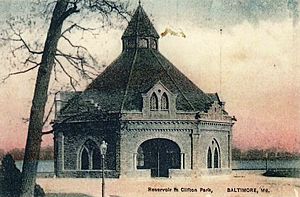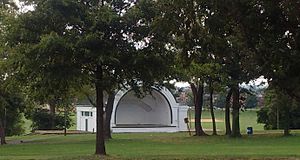Clifton Park, Baltimore facts for kids
Quick facts for kids |
|
|
Clifton Park
|
|

"Clifton Mansion", original home of Capt. Henry Thompson, (1774-1837), later purchased 1838 by Johns Hopkins, (1795-1873), renovated/redesigned around 1858 by architectural team of Niernsee and Neilson, photo taken August 2011
|
|
| Location | Bounded by Harford Rd., Erdman Ave., Clifton Park Terrace, the Baltimore Belt RR and Sinclair Ln., Baltimore, Maryland |
|---|---|
| Area | 266.7 acres (107.9 ha) |
| Built | 1801 |
| Architect | Niersee & Neilson; Wyatt and Nolting; Olmsted Brothers; Thomas, Frederick |
| Architectural style | Italian Villa, Gothic Revival, Late 19th & 20th C. Revival |
| NRHP reference No. | 07000941 |
| Added to NRHP | September 12, 2007 |
Clifton Park is a large public park and a historic area in Baltimore, Maryland. It is located in the northeast part of the city. The park is surrounded by neighborhoods like Coldstream-Homestead-Montebello, Waverly, Belair-Edison, Lauraville, and Hamilton.
Clifton Park is bordered by Erdman Avenue, Sinclair Lane, Harford Road, and Belair Road. A big part of the park is the eighteen-hole Clifton Park Golf Course. This course hosts the yearly Clifton Park Golf Tournament.
Contents
The Story of Clifton Park
Early Days: The Thompson Family
The land where Clifton Park now stands was once a farm. Around 1803, a house was built here. It was the summer home of Captain Henry Thompson (1774-1837). He was born in Sheffield, England, and came to Baltimore around 1794.
Thompson became an important person in Baltimore. He was a merchant, a banker, and a company leader. He also cared about his community. He joined the Maryland State Militia in 1809 as a cavalry officer. In 1813, he formed the "First Baltimore Horse Artillery." This group helped defend Baltimore during the War of 1812. They fought in the Battle of Baltimore and saw the bombardment of Fort McHenry. This event inspired the writing of The Star-Spangled Banner.
Thompson also helped build Harford Road. He was part of a group that planned new streets for Baltimore. This helped the city grow. He also served on the boards of important companies and banks. He was honored at the ceremonies for the Battle Monument and the Washington Monument. In 1824, he was the Grand Marshall when the French hero Marquis de Lafayette visited Baltimore. Thompson owned the Clifton estate until about 1835. He passed away in 1837.
A Visionary's Estate: Johns Hopkins
In 1838, Johns Hopkins (1795-1873) bought Clifton. He was a local merchant, banker, and a very generous person. He developed the estate with a lake and a large collection of sculptures. In 1858, the beautiful Clifton Mansion was built. It has an Italianate-style design with a tall tower. Architects John Rudolph Niernsee and James Crawford Neilson designed it.
Hopkins planned to build his new Johns Hopkins University on the Clifton property. However, he died before his dream came true. The university was later built in downtown Baltimore.
Even before the city bought the estate, part of the land was used for a reservoir. This was for the city's water supply. It was called Lake Clifton. This 30-acre lake was 30 feet deep and held 265 million gallons of water. It started working on December 27, 1888. The Clifton Park Valve House was built in 1887 to control the water flow into the lake. It is an 8-sided stone building with a cone-shaped roof. It had stained glass windows, but these were later damaged. The valve house is still there, but it needs repairs.
Becoming a Public Park
In 1894, Johns Hopkins University sold the Clifton estate to Baltimore City. The city wanted to use it as a park. This added to Baltimore's growing system of parks.
The park was developed with a band shell. Outdoor concerts were very popular here in the 1920s and 1930s. A streetcar line also ran along the park's Harford Road border until 1956.
Clifton Park was used by the Maryland National Guard in April 1968. Troops camped there during a time of unrest in Baltimore. They guarded the streets during the day and slept at the park at night.
Fun Things to Do at Clifton Park
Since 1915, part of the estate has been a public golf course. It was the first public golf course in Baltimore. For many years, the old Clifton Mansion served as the golf course's pro shop. It also housed offices for the Baltimore City Department of Recreation and Parks. In 2019, the Clifton Mansion was renovated. Now, it is the home of Civic Works, a local non-profit group.
In 1916, the Peabody Institute gave Baltimore City a bronze sculpture called "On the Trail." It is a 7-foot-4 statue of a Native American man. Local artist Edward Berge created it. The statue sits on a large boulder in Clifton Park.
The St. Vincent de Paul Roman Catholic Church has an old cemetery near the park. It is a seven-acre burial ground for about two thousand people. Most of them were Irish, German, and Italian. The cemetery was damaged in the 1960s and closed in the 1980s. In 2010, a group called "Friends of St Vincent's Cemetery" began cleaning and maintaining it.
Lake Clifton was drained in the late 1960s to build Lake Clifton High School. This school opened in September 1971. It is one of the largest school campuses in the Baltimore City Public Schools system. The school was built to help with overcrowding after World War II. Later, Eastern High School merged with Lake Clifton High School. For a while, it was known as "Lake Clifton-Eastern High School." Today, the "Lake Clifton Campus" has two smaller schools: Heritage High School and the REACH! Partnership School.
Clifton Park is also home to "Real Food Farm." This is a 6-acre urban farm managed by Civic Works, Inc. It started in 2009. The farm helps bring fresh food to nearby neighborhoods. It also shows how urban farming can be successful. Students from Heritage, REACH!, and other public city schools can learn there.
Clifton Park was added to the National Register of Historic Places in 2007.
- Clifton Park, Baltimore City, including photo from 1995 and boundary map, at Maryland Historical Trust






